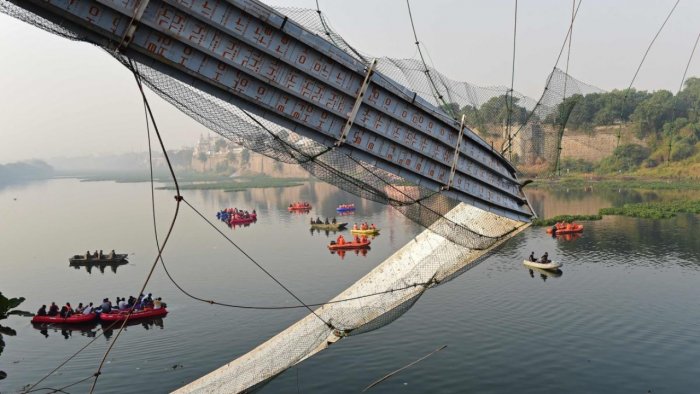
Corroded wires, welded suspenders led to Morbi bridge tragedy: SIT report

The Gujarat government-appointed Special Investigation Team (SIT) has in its preliminary probe found that corrosion on nearly half of the wires on a cable and welding of old suspenders with new ones were some of the major faults that led to the collapse of a suspension bridge in Morbi last year in which 135 people were killed.
Of the two main cables of the British-era bridge, built by the erstwhile rulers in 1887 over the Machchhu river, one cable was having issues of corrosion and nearly half of its wires “may be already broken” even before the cable snapped on the evening of October 30, 2022, the SIT noted.
Also read: Morbi bridge collapse: Oreva’s Jaysukh Patel surrenders, gets jail custody
The main cable on the upstream side of the river snapped, leading to the tragedy, as per the SIT.
The findings are part of the Preliminary Report on Morbi Bridge Incident submitted by the five-member SIT in December 2022. The report was recently shared by the state Urban Development Department with the Morbi Municipality.
Ajanta Manufacturing Limited (Oreva Group) was responsible for the operation and maintenance of the British-era suspension bridge on the Machchhu river which collapsed on October 30, 2022.
Watch: Morbi bridge collapse: 1,262-page chargesheet filed against Oreva chief Jaysukh Patel
The SIT found several lapses in repairs, maintenance and operation of the bridge.
Each cable was formed by seven strands, each comprising seven steel wires. Total 49 wires were clubbed together in seven strands to form this cable, the SIT report said.
“It was observed that out of the 49 wires (of that cable), 22 were corroded, which indicates that those wires may have already broken before the incident. The remaining 27 wires recently broke,” it said.
The SIT also found that during the renovation work, “old suspenders (steel rods which connect the cable with the platform deck) were welded with the new suspenders. Hence the behaviour of suspenders changed. In these types of bridges, single rod suspenders should be used to bear the load”.
Also read: Morbi tragedy: No political fallout, no poll issue; only courts seem concerned
Notably, the Morbi Municipality, without the approval of the general board, had awarded the contract to maintain and operate the bridge to Oreva Group (Ajanta Manufacturing Limited), which had closed the bridge in March 2022 for renovation and opened it on October 26 without any prior approval or inspection.
According to the SIT, there were nearly 300 people on the bridge at the time of collapse, which was “far more” than its load-bearing capacity.
It, however, said the actual capacity of the bridge will be confirmed by laboratory reports.
The probe report also pointed out that replacing individual wooden planks with an aluminium deck also played a role in the collapse.
“Walking structure was made up of rigid aluminium panels instead of flexible wooden planks. If there were individual wooden planks (which were there before renovation), the number of casualties could have been lower. Moreover, no load test or structure test was conducted before opening the bridge,” it added.
The aluminium honeycomb panels were fixed without any gap in between, which makes the deck less flexible to deform in its own plane, the SIT said, adding the use of aluminium could have increased the overall weight of the bridge too.
IAS officer Rajkumar Beniwal, IPS officer Subhash Trivedi, a secretary and a chief engineer from the state Roads and Building Department and a professor of structural engineering were members of the SIT.
The Morbi police have already arrested 10 people, including Oreva Groups MD Jaysukh Patel, and booked them under Indian Penal Code sections 304 (culpable homicide not amounting to murder), 308 (attempt to commit culpable homicide), 336 (act which endangers human life), 337 (causing hurt to any person by doing any rash or negligent act) and under 338 (causing grievous hurt by doing rash or negligent act).
(With agency inputs)


